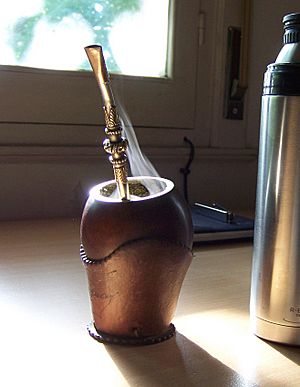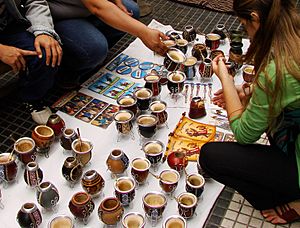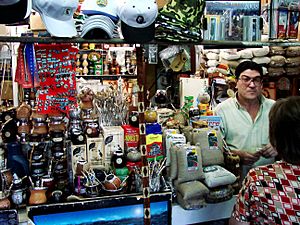Yerba mate facts for kids
Quick facts for kids Yerba mate |
|
|---|---|
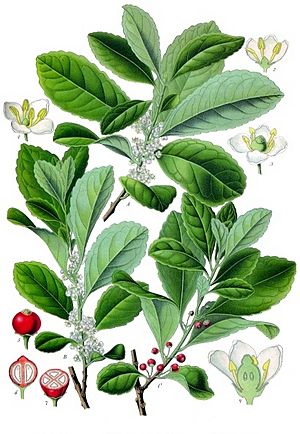 |
|
| Ilex paraguariensis | |
| Conservation status | |
| Scientific classification | |
| Genus: |
Ilex
|
| Species: |
paraguariensis
|
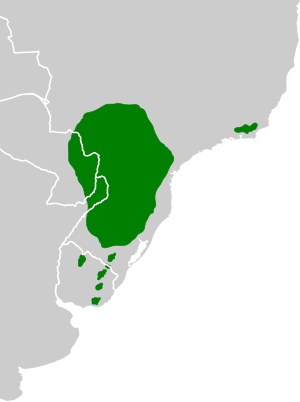 |
|
| Native range of Ilex paraguaiensis | |
Yerba mate (Ilex paraguariensis) is a plant from the holly family. It grows naturally in South America. The French scientist Augustin Saint-Hilaire gave it its name.
People use the leaves of this plant to make a popular drink called mate. They steep the leaves in hot water. If they use cold water, it's called tereré. Both the plant and the drinks contain caffeine.
The Guaraní and some Tupi communities in Paraguay were the first to grow and drink yerba mate. This was long before Europeans came to the Americas. Later, the Jesuits saw how popular it was. They helped spread yerba mate throughout the region and beyond.
Today, mate is a very common drink in South America. It is popular in Paraguay, Argentina, Uruguay, and southern Brazil. People also drink it in parts of Bolivia and Chile. Thanks to immigrants from the 1800s, it's also popular in Syria and Lebanon. You can even find yerba mate in energy drinks and bottled iced tea around the world.
Contents
What Does "Yerba Mate" Mean?
The Guaraní people, who first used mate, called the plant ka'a. This word means 'herb'. The word mate comes from the Quechua word mati. This word means 'container for a drink' or 'infusion of an herb'. It also means 'gourd', which is the traditional cup for mate.
In Spanish, yerba means 'herb' or 'grass'. In Argentina, yerba usually means only the yerba mate plant. So, yerba mate literally means 'the gourd herb'. This is because people drink it from a gourd.
In English, you might see it spelled mate or maté. The spelling maté is not correct in Spanish or Portuguese. It makes it sound like the stress is on the second part of the word. But the correct way to say it is with the stress on the first part, like "MAH-tay". The extra mark on the "e" in English was probably added to show that the "e" is not silent.
What Does the Yerba Mate Plant Look Like?
The yerba mate plant starts as a small shrub. Then it grows into a tree, reaching up to 15 meters (about 50 feet) tall. Its leaves stay green all year round. They are about 7 to 110 millimeters (0.3 to 4.3 inches) long and 30 to 55 millimeters (1.2 to 2.2 inches) wide. The edges of the leaves are jagged.
These leaves contain caffeine and other similar natural chemicals. Farmers harvest the leaves to sell them. The plant also has small, greenish-white flowers with four petals. Its fruit is a red berry, about 4 to 6 millimeters (0.16 to 0.24 inches) across.
History of Yerba Mate
The Guaraní people and some Tupi people in Paraguay were the first to drink mate. When Europeans arrived, mate became very popular in the Spanish colony of Paraguay. Both Spanish settlers and indigenous people drank it. Yerba mate became a very important product for Paraguay. People used the labor of indigenous people to collect the wild plants.
In the mid-1600s, Jesuits learned how to grow the plant on farms. They started plantations in Argentina. This created competition with Paraguay, which mostly collected wild mate. After the Jesuits left in the 1770s, their farms were not kept up.
Yerba mate remained important for Paraguay's economy after it became independent. But the Paraguayan War (1864–1870) greatly harmed the country. Some areas with mate farms in Paraguay became part of Argentina.
Brazil then became the biggest producer of mate. In the late 1800s and early 1900s, Brazil and Argentina learned how to grow mate on farms again. This led to large plantation systems. When Brazil focused on coffee in the 1930s, Argentina became the largest producer. Today, Brazil is the biggest producer (53%), followed by Argentina (37%), and Paraguay (10%).
In Brazil, there is a Mate Historic Park. It teaches people how to harvest mate in a way that protects the oldest wild mate forests.
How Yerba Mate is Grown

Yerba mate is grown and processed in its native areas of South America. These include Paraguay, parts of northern Argentina, Uruguay, and southern Brazil. The people who grow mate are called yerbateros in Spanish.
Farmers collect seeds for new plants when they turn dark purple, usually from January to April. They put the seeds in water to remove bad seeds and debris. New plants are started between March and May.
Some insects can harm yerba mate plants. These include a bug called Gyropsylla spegazziniana and a type of beetle called Hedyphates betulinus. Moths and mites can also cause problems. Scientists have found ways to control some of these pests using natural methods.
When yerba mate is harvested, the branches are often dried over a wood fire. This gives the mate a smoky taste. The flavor and caffeine levels can be different between male and female plants. Female plants usually have a milder flavor and less caffeine.
How People Drink Yerba Mate
The drink, called mate, is made by filling a special cup. This cup is often a hollowed-out gourd. It is filled about three-quarters full with dry yerba mate leaves and twigs. Then, hot water (around 70–80°C or 158–176°F) is added. The water should be hot but not boiling. Some people add sugar. If cold water is used, it's called tereré.
Drinking mate is a common social activity in many South American countries. Friends and family often share mate from the same cup. They drink it through a special metal or wooden straw called a bombilla. One person, the brewer, prepares the mate and passes the cup around. Each person drinks a few sips and then returns the cup to the brewer. The brewer refills it and passes it to the next person. It's polite not to say "thank you" until you are finished drinking for good.
While traditional cups are gourds, today they are also made from wood, glass, or other materials. Just like people meet for coffee or tea, friends often gather to drink mate. On hot days, some people replace the hot water with lemonade. Paraguayans often drink cold mate (tereré) on hot days and hot mate in the mornings or cooler weather.
Yerba mate is very popular in Paraguay and Uruguay. People there often walk around carrying their mate cup and a thermos of hot water. In Uruguay, people drink about 10 kilograms (22 pounds) of yerba mate per person each year. This is a lot because you use more herb for mate than for tea.
The taste of mate is often described as a mix of vegetables, herbs, and grass. It can taste like some green teas. It is usually bitter if made with hot water. You can also find sweetened and flavored mate, sometimes mixed with other herbs like peppermint or citrus.
Another way to drink mate is called mate cocido (cooked mate) or chá mate in Brazil. This version is sold in teabags or as loose leaves. It is often served sweetened, hot or iced, sometimes with fruit juice or milk. People commonly drink this for breakfast or afternoon tea, often with pastries.
An iced, sweetened version of mate cocido is sold as a soft drink. In Brazil, this cold chá mate is very popular in stores. Mate batido is a toasted version that is less bitter and has a spicier smell. It becomes creamy when shaken.
In Paraguay and parts of Brazil and Argentina, tereré is a cold or iced mate drink. People usually drink it from a horn cup called a guampa with a bombilla. The Guaraní people drank it this way long ago, but without ice. Tereré can be made with cold water or fruit juice. Water makes it more bitter, while fruit juice adds sweetness. People sometimes add medicinal or cooking herbs, called yuyos, to the water for flavor or health reasons.
Mate has also become popular outside South America. It is commonly drunk in Lebanon, Syria, and other parts of the Middle East. This is mainly because people from those areas moved to South America and then returned home.
Materva is a sweet, fizzy soft drink based on yerba mate. It was created in Cuba in 1920 and is popular in Miami, Florida.
What's in Yerba Mate?
Yerba mate contains natural substances called polyphenols, like flavonoids. It also has three types of xanthines: caffeine, theobromine, and theophylline. Caffeine is the main one. The amount of caffeine can be different, but it's usually between 0.7% and 1.7% of the dry leaves. Yerba mate also has important minerals like potassium, magnesium, and manganese.
Yerba Mate and Health
Some studies have looked at whether yerba mate can help with weight loss. While some research suggests it might have positive effects, there isn't strong proof that it directly helps people lose weight.
Drinking very hot drinks, including hot mate tea, has been linked to a higher risk of certain cancers in the mouth and throat. However, studies show that the temperature of the drink is the main factor, not necessarily the mate itself. Drinking any very hot beverage can increase this risk.
See also
 In Spanish: Yerba mate para niños
In Spanish: Yerba mate para niños
- Black drink
- Club-Mate
- Matte Leão
- Ilex guayusa, known as guayusa, another caffeine-containing holly species of the Ilex genus, native to the Ecuadorian Amazon rainforest
- Ilex vomitoria, a caffeine-containing species of the Ilex genus native to North America
- Kuding, Ilex kudingcha
- Materva
- Nativa
- Guayaki
- Yerba Mate Playadito




